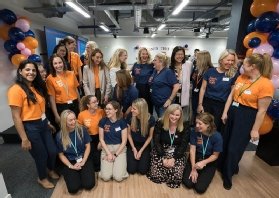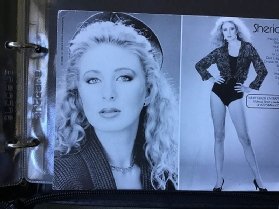“My husband has to sew my buttons on – I still can't sew,” confesses co-CEO of technology education charity Tech She Can, Sheridan Ash.
This year's Computer Weekly most influential woman in UK technology has always had a sense of wanting to right the injustice inflicted on women by gender stereotyping,
“At school, the girls had to do sewing or needlework or typing, and the boys did metalwork and woodwork. So I went to the local newspaper. I set up a petition. I got other pupils to stand outside the school with placards. Anyway, I got it changed. Hence, I can't sew or type, but I'm great at welding,” says Ash.
Computer Weekly attended the launch of the first Tech She Can research eight years ago, when it was still a part of Ash's work at PwC,
Ash has since left the professional services firm to focus on the technology education charity full-time, but like many women in the tech sector, her journey has not been linear.
Ash left school at 16 with no qualifications, which she puts down, in part, to undiagnosed dyslexia. Not knowing what to do, she accepted a modeling job she was offered when window shopping with her mother in London.
While this sufficed for a while, in her early 20s, Ash needed a career change for various reasons. After getting help with her dyslexia, she returned to education to study psychological sciences, then worked in the pharmaceutical industry before returning to school again to gain a master's in business administration.
Eventually, Ash was offered a job at PwC to implement the firm's health and technology practice.
Pushing for equality
Ash has always been passionate about equality – hence wanting to weld at school – and in her role at PwC, she started to notice the diversity gap in the technology sector.
“What was going wrong? Why was it so predominantly male?” she found herself wondering at the time.
After the firm selected its first technology leader to sit on the board, the work Ash had done to collect data around diversity, both within PwC and the wider sector, began to pay off in a big way.

She explains: “I worked directly for that technology leader. I wrote the whole technology and innovation strategy for the firm, and at the heart of that, I embedded the piece around diversity.”
It was when working with the board of PwC eight years ago that Ash was inspired to commission the first piece of research on diversity, which eventually evolved into the Tech She Can movement.
Ash says while there had been research at the time about the lack of women in the sector and the reasons for that, there was not enough around why younger girls were overlooking jobs in tech.
After asking thousands of young people between the ages of 18 and 24, Ash explains: “They said, 'We know who Sheryl Sandberg is, and Ada Lovelace, but one's been dead a long time and the other's a COO'. What they were looking for is relatable role models, people [in roles] they could see a pathway to.”
The research also found girls were less likely than boys to have technology suggested to them as a career option by others in their lives, such as teachers, parents or career advisors.
Girls were also more likely to say they wanted a career that has a positive impact on society, but Ash speculates the digital native generations don't see how technology can achieve that because it's so embedded in their lives.
She explains: “They wanted to have a positive impact on themselves, the community, their family, the UK and the wider world, and they didn't understand the relationship between technology and doing that.”
Recognizing that no single person or organization will be able to shift the dial alone, Tech She Can is focused on acting as a “bridge” between government, schools and industry.
“We're quite good at bridging that demand and supply [gap]along with [addressing] what's putting girls off, the perception issues and all of those things,” Ash claims. “Often, you don't get [to hear] teachers', schools' and children's voices.”
Changing perceptions
Tech She Can was launched as a charter with 18 partner organizations to collaborate on improving the pipeline of women going into technology roles. As part of this, it has become focused on helping educate children about tech careers.
A common barrier between young girls and tech careers is a lack of understanding about what a tech career involveswhat roles are available, how to go about pursuing a tech career, and the kinds of people who work in the industry,
This goes hand in hand with a lack of visible and accessible role modelsas young women are less likely to be drawn to a career if they don't see anyone like them in such roles.
Photographer: Elyse Marks
“I want to persuade girls they have a role to play in making sure that the world isn't just developed by a lot of white tech bros, that they could be part of making sure the world is a fit place for everybody, and that it is somewhere women are treated equally in creating that world”
Sheridan Ash, Tech She Can
Ash urges: “We've got to start changing these perceptions and addressing the inspiration and aspiration gaps very early on, and children's understanding of what technology is and what roles and careers there are out there. Nobody seems to be doing that.”
Tech She Can regularly visits schools and provides online learning to prepare young people for technology careers, educating them about possible roles and how technology will play a role in their future careers. It also helps government and industry “connect” with schools with the aim of closing the technology skills and diversity gaps.
“We don't teach the coding. We teach the inspiration, the aspiration, and show them how the technology they can use [translates into] careers and jobs.”
Last year, Ash left PwC to pursue Tech She Can full-time, launching the initiative as a charity in partnership with co-CEO Claire Thorne.
The program has gone from strength to strength. It now has 200 member organizations, 800 registered “champions”, and has reached more than 130,000 children.
At a time when so many organizations are stepping back when it comes to implementing diversity and inclusion in their technology remit, how does Tech She Can make sure those involved are not using it as lip service?
“What we concentrate on is what we call our 'strategic partners', which are the people who fund us, and across all our partners we train champions to go into schools, we package up all our live lessons in a way that the champions can take them out and deliver them in person. In primary schools, they often do it to a whole assembly, and in secondary schools, it's usually to individual classes.”
During these sessions, the champions explain technology concepts, how they apply in the real world and what tech jobs involve, which over time has changed the way children perceive technology, the subjects they choose to study and what careers they consider in the future.
Underpinning it all is data. For example, the organization uses social mobility data to ensure it offers its services to schools that have the greatest need for it.
Being Wonder Woman
Wearing other hats, Ash is a non-executive director for several other organizations, leaning into her life-long need to help women achieve equality.
But she still has moments when she needs to perform a Wonder Woman-style power pose to amp herself up.

We often talk about technology role models, and in Ash's childhood, she aspired to be Wonder Woman.
“She kicked the ass of the baddies,” she says. “She wanted to have a positive impact. She did good shit. And that felt right from a young age, whether I was conscious or not about what I wanted in life.”
There is plenty of research highlighting the importance of role models for young womenespecially in the technology space. Ash is a role model herself.
Ash says she wants every young woman to know that not only is technology a “joyful” career, but it is going to be “one of the most important factors of shaping her world”.
She says: “I want to persuade girls they have a role to play in making sure that the world isn't just developed by a lot of white tech bros, that they could be part of making sure the world is a fit place for everybody , and that it is somewhere women are treated equally in creating that world.”


